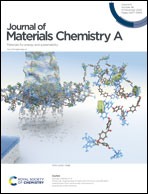Investigation of superior sodium storage and reversible Na2S conversion reactions in a porous NiS2@C composite using in operando X-ray diffraction†
Abstract
Herein, a nickel disulfide–carbon (NiS2@C) composite with an advanced architecture is proposed as a high-performance anode material for SIBs. The NiS2@C composite is prepared via a one-pot hydrothermal method using Ni-based metal–organic frameworks as a single precursor following the sulfidation route. The highly conductive and porous nature of NiS2@C not only provides high electronic conductivity and a facile Na+-ion diffusion pathway but also decreases the stress/strain of the material during the conversion reaction process. Hence, despite very low carbon contents (∼8.5 wt%), the proposed composite material demonstrates high initial capacity (800 mA h g−1), excellent long-term cycling ability over 500 cycles, and fast charge–discharge capability even at a high current density of 5 A g−1. For the first time, the reversible Na2S conversion reaction is investigated via in operando X-ray diffraction analysis.



 Please wait while we load your content...
Please wait while we load your content...